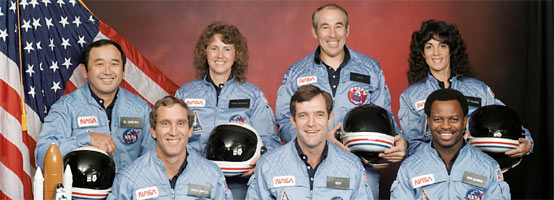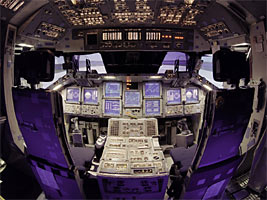|
To assist
in honing the interaction between crews and the shuttle
systems, the shuttle mission simulators provided integrated
training for crews, the MCC and mission operators, payload
support groups, and tracking and telemetry systems. The SMS
provided real-time simulation capability for all phases of
shuttle orbital flight. Still vital in training today, its
three basic stations, a fixed-based crew station, a network
simulation system and a motion-base crew station, became
operational in 1978.

Five
astronauts and two payload specialists made up the crew that
flew aboard the Space Shuttle Challenger in January 1986.
Crewmembers were (left to right, front row) astronauts Michael
J. Smith, Francis R. (Dick) Scobee and Ronald E. McNair; and
Ellison S. Onizuka, Sharon Christa McAuliffe, Gregory Jarvis
and Judith A. Resnik. McAuliffe and Jarvis were payload
specialists, representing the Teacher in Space Project and
Hughes Co., respectively. On Jan. 28, 1986, the seven
Challenger crewmembers lost their lives following an explosion
during the launch phase of the STS-51L
mission.
In
addition, with crews of six or eight flying aboard, the space
shuttle changed the sociology of space flight. Astronauts were
divided into two categories: pilots responsible for flying and
maintaining the orbiter and mission specialists responsible
for experiments and payloads.
JSC's
lead center role for the shuttle begun in the 1970s continues
to this day. More importantly, its other role begun in the
1970s, that as a research and development center leading Texas
into a new era of economic and industrial development,
continues today.
The space
shuttle introduced several new tools to the business of space
flight including the shuttle's robot arm, the Remote
Manipulator System. The shuttle has been used for numerous
satellite repair and deployment missions. In 1992, the crew of
STS-49, for example, successfully captured, repaired and
redeployed the INTELSAT VI satellite, which had been stranded
in an unusable orbit since its launch in March 1990. Since
returning to flight in 1988, the shuttle has carried only
those payloads unique to the shuttle or those requiring a
human presence. The majority of these have been scientific
payloads including some critical space science projects
including the Hubble Space Telescope, the Galileo Jupiter
spacecraft and the Gamma Ray Observatory.

This "fish-eye" view illustrates NASA's
Multifunction Electronic Display Subsystem, otherwise
known as the "glass cockpit." It represents a number of
important modifications that have been accomplished on
the Orbiter's flight deck. This photo is actually one of
the fixed base space shuttle mission simulator in the
Johnson Space Center's Mission Simulation and Training
Facility. The fixed base simulator was outfitted with
MEDS to be used by flight crews for
training. |
In 1995,
the shuttle added a new capability to its repertoire. In
preparation for International Space Station development, the
crew of the space shuttle began a series of eight dockings and
five crew exchanges with the Russian space station Mir. More
recently, the shuttle has been used as the workhorse for space
station assembly, carrying supplies and components to the ISS
including the U.S. Unity module, the U.S. Destiny Laboratory,
Canadarm2 (the station's new robotic arm) and the U.S. Joint
Airlock used to conduct spacewalks from the
station.
Twenty
years and more than 100 missions after its first flight, the
space shuttle remains the key vehicle in the world's space
transportation system. Since its inception, more than 260
astronauts-American and international-have flown aboard the
space shuttle. And the shuttle fleet is only about half way
through its planned lifetime.
"I
believe that the space shuttle, the world's only reusable
launch vehicle, will fly at least another 100 missions over
the course of the next 15 to 20 years," said NASA Space
Shuttle Program Manager Ron Dittemore. "It will continue to
play a key role as the workhorse of American space
transportation in carrying International Space Station crews
and components to and from the orbiting outpost and performing
a number of other vital missions in support of science,
engineering and exploration." |





